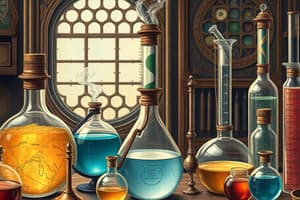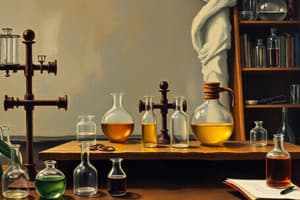Podcast
Questions and Answers
What is the primary use of a graduated cylinder?
What is the primary use of a graduated cylinder?
- To mix chemicals
- To measure volumes of liquids (correct)
- To hold solids or liquids during a reaction
- To collect large volumes of gases
Which of the following is NOT a primary function of rubber stoppers?
Which of the following is NOT a primary function of rubber stoppers?
- To prevent spillage
- To close containers
- To aid in gas collection (correct)
- To avoid contamination
What can happen if a test tube with a rubber stopper is heated?
What can happen if a test tube with a rubber stopper is heated?
- The test tube may crack due to pressure buildup
- The stopper enhances the heating process
- The contents will boil more efficiently
- The rubber stopper can melt (correct)
What is the purpose of a glass stir rod in the laboratory?
What is the purpose of a glass stir rod in the laboratory?
Under which condition would you use gas collecting bottles?
Under which condition would you use gas collecting bottles?
Which of the following statements accurately describes the Erlenmeyer flask?
Which of the following statements accurately describes the Erlenmeyer flask?
What is a common use for forceps in a laboratory setting?
What is a common use for forceps in a laboratory setting?
Which type of paper is utilized to identify bases?
Which type of paper is utilized to identify bases?
What is the primary use of a funnel in a laboratory setting?
What is the primary use of a funnel in a laboratory setting?
Which item should be used with care when handling high temperatures?
Which item should be used with care when handling high temperatures?
When using a Mohr pipet, what is important to ensure?
When using a Mohr pipet, what is important to ensure?
What are beaker tongs specifically used for?
What are beaker tongs specifically used for?
What is the intended use of a wash bottle in the lab?
What is the intended use of a wash bottle in the lab?
Which tool is most suitable for heating certain solids to very high temperatures?
Which tool is most suitable for heating certain solids to very high temperatures?
What role does a clay triangle play in laboratory setups?
What role does a clay triangle play in laboratory setups?
Which of the following is true about triangular files?
Which of the following is true about triangular files?
Flashcards
Beakers
Beakers
Used to hold liquids or solids that are unlikely to release gases when reacted or splatter when stirred/heated
Erlenmeyer Flasks
Erlenmeyer Flasks
Useful for holding substances that may release gases or splatter when stirred or heated
Florence Flasks
Florence Flasks
Used for mixing chemicals with a narrow neck to prevent splashes.
Graduated Cylinders
Graduated Cylinders
Signup and view all the flashcards
Gas Collecting Bottles
Gas Collecting Bottles
Signup and view all the flashcards
Test Tube Holders
Test Tube Holders
Signup and view all the flashcards
Test Tube Brushes
Test Tube Brushes
Signup and view all the flashcards
Rubber stoppers
Rubber stoppers
Signup and view all the flashcards
Glass Stir Rods
Glass Stir Rods
Signup and view all the flashcards
Medicine Droppers
Medicine Droppers
Signup and view all the flashcards
Litmus Paper
Litmus Paper
Signup and view all the flashcards
Funnels
Funnels
Signup and view all the flashcards
Mohr Pipets
Mohr Pipets
Signup and view all the flashcards
Spatulas
Spatulas
Signup and view all the flashcards
Bunsen Burners
Bunsen Burners
Signup and view all the flashcards
Wire Gauze
Wire Gauze
Signup and view all the flashcards
Study Notes
Basic Laboratory Equipment
- Beakers are used to hold solids or liquids that won't release gases when reacted or are unlikely to splatter if stirred or heated.
- Erlenmeyer Flasks are used to for solids or liquids that may release gases during a reaction or are likely to splatter if stirred or heated.
- Florence Flasks are used for mixing chemicals. They have a narrow neck to prevent splashes.
- Graduated Cylinders are used to measure volumes of liquids.
- Gas Collecting Bottles are used for collecting large volumes of gases, often by water displacement.
- Test Tubes (13 x 100 mm) and Test Tubes (10 x 75 mm) are common sizes for holding and reacting small quantities of liquids or solids.
- Test Tube Holders are used to safely hold test tubes that are too hot to handle.
- Test Tube Brushes are used to clean test tubes and graduated cylinders, but be careful not to force a large brush into a small test tube as it can break the tube.
- Test Tube Racks organize and hold test tubes. Plastic racks can melt in contact with very hot test tubes.
- Rubber Stoppers are used to close containers to avoid spillage or contamination. Never heat a container with a stopper in place.
- Glass Stir Rods are used to manually stir solutions and to transfer single drops of a solution.
- Medicine Droppers are used to transfer small volumes of liquid (less than one mL) and use a “rubber bulb" on top.
- Litmus Paper is used to identify acids and bases. Red litmus paper turns blue in the presence of a base, while blue litmus paper turns red in the presence of an acid.
- Forceps are used to pick up small objects.
- Funnels are used to aid in the transfer of liquids from one vessel to another.
- Mohr Pipets are used to measure and deliver exact volumes of liquids.
- Wash Bottles are used to deliver a wash solution to a specific area. Distilled water is the only liquid that should be used in a wash bottle.
- Weighing Boats are used to weigh solids that will be transferred to another vessel.
- Spatulas are used to dispense solid chemicals from their containers. Never transfer chemicals with your bare hands.
- Beaker Tongs are used to move beakers containing hot liquids.
Heating and Support Equipment
- Bunsen Burners are used for heating nonvolatile liquids and solids.
- Evaporating Dishes are used for heating stable solid compounds and elements.
- Crucibles are used for heating certain solids, particularly metals, to very high temperatures.
- Clay Triangles are used as a support for porcelain crucibles when being heated over a Bunsen burner.
- Crucible Tongs are used for handling hot crucibles and other hot objects. NEVER use them to pick up beakers!
- Glass Plates are used for semi-micro scale experiments, such as drop reactions and testing acids and bases.
- Triangular Files are used to cut glass, a skill that would be taught by an instructor when needed.
Supporting and Clamping Equipment
- Ringstands are a safe and convenient way to perform reactions that require heating using a Bunsen burner.
- Iron Rings connect to a ringstand to provide a stable, elevated platform for the reaction.
- Utility Clamps are used to secure test tubes, distillation columns, and burets to the ringstand.
- Double Buret Clamps are used to secure burets, which are long graduated tubes used in titration.
- Wire Gauze sits on the iron ring to provide a place to safely stand a beaker.
Studying That Suits You
Use AI to generate personalized quizzes and flashcards to suit your learning preferences.





